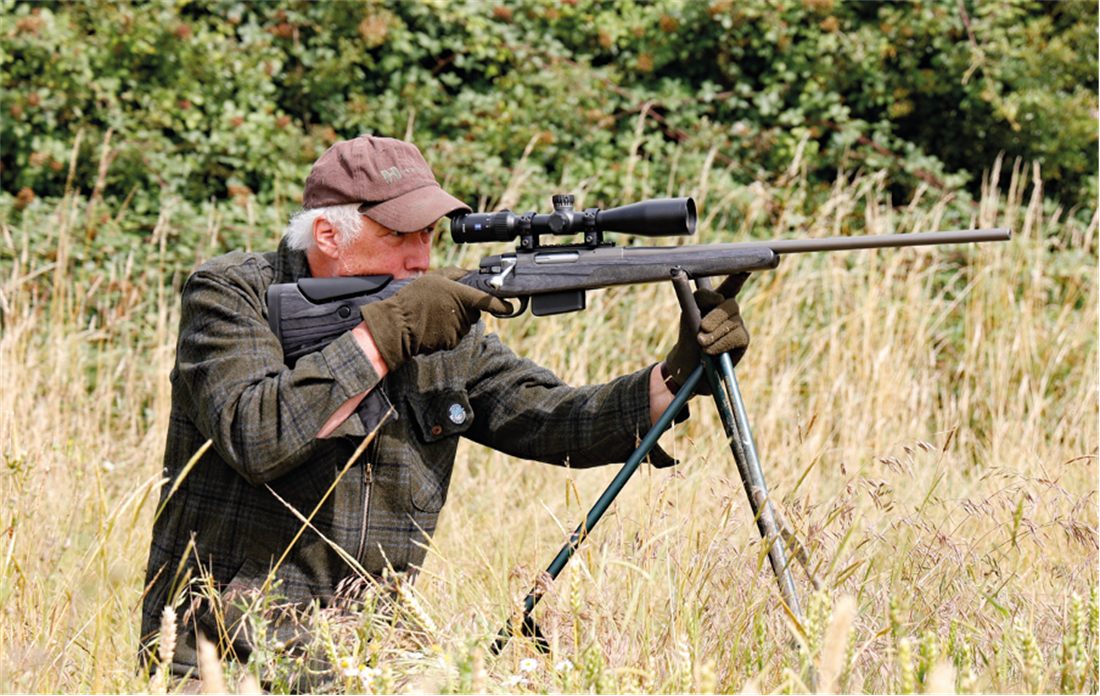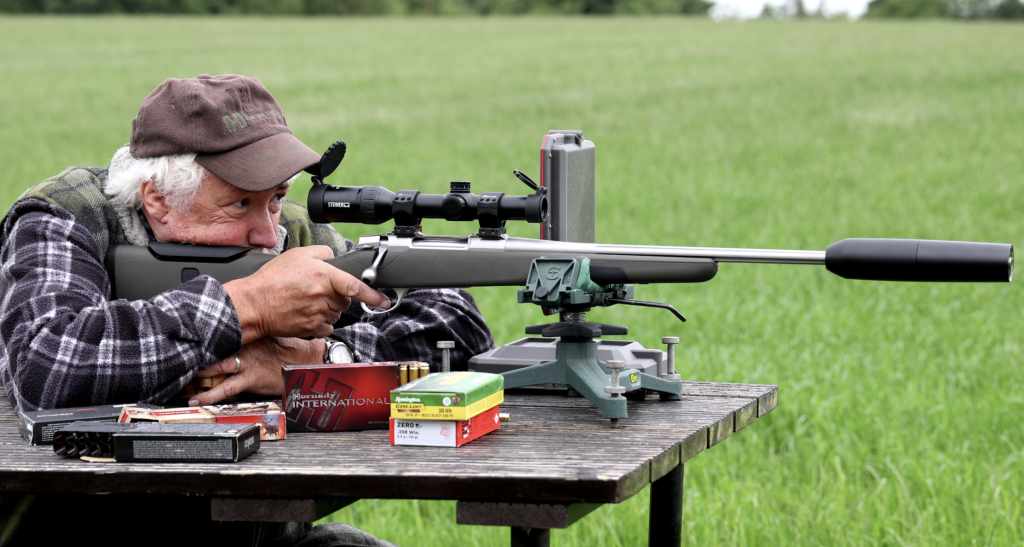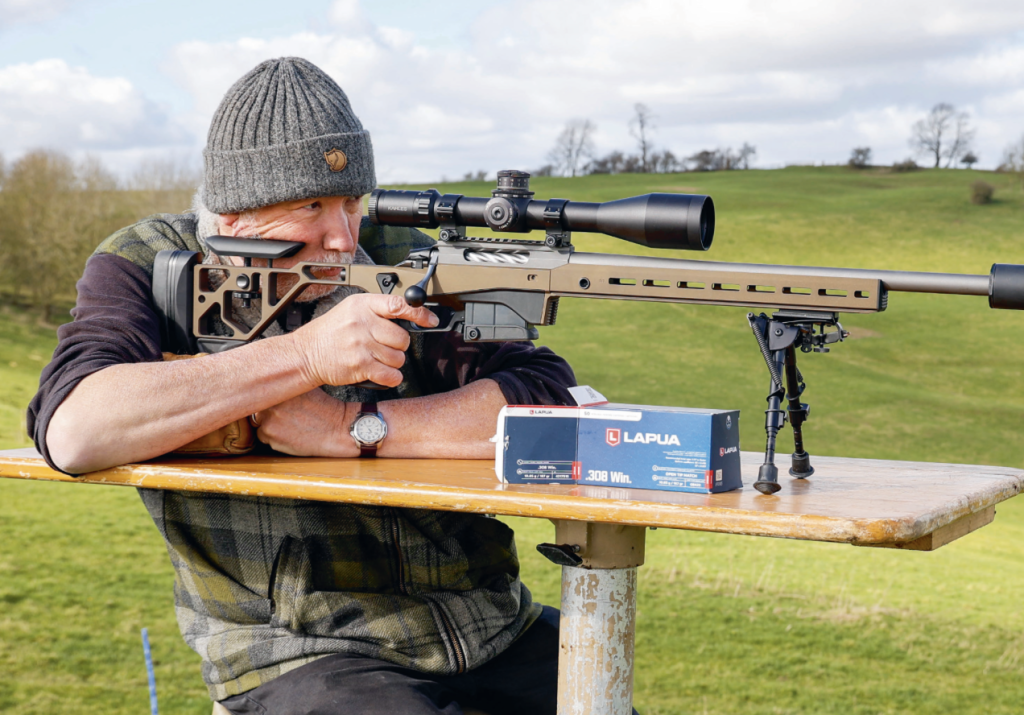AFFORDABLE INNOVATION
ATA, well known for its shotguns, has entered the bolt-action centrefire rifle market with a range of well-designed, cost-effective options. Bruce Potts gives his opinion

Turkish gun manufacturers have long been known for their cost-effective and diverse range of shotguns in various styles, calibres and options. It was about time they turned their attention to the centrefire rifle market, and this is what ATA, from Istanbul, has done. ATA, one of the better Turkish shotgun makers, has made massive inroads into the British shotgun market with their popular models. Now it’s the turn of the company’s Turqua, a brand-new bolt-action centrefire.
Prices start as low as £599.99 for the Turqua synthetic stock in either black or green finish, while a walnut-stocked version retails for £674.99. A Monte Carlo stocked version is available at £734.99. For only an additional £10 you get an adjustable cheekpiece walnut model, or for an additional £100 a CLR black synthetic or camo/bronze finished rifle. These are all hunter-type models, but ATA has gone all out with the PT version of the Turqua, which retails at only £1,024.99 and has a laminated semi-tactical stock configuration. You can even order the ALR or ALR folding (£1,239.99, £1,388.99 respectively), which is a chassis-based tactical rifle outfit. Or increase the budget to £4,273.99 with the law-enforcement type tactical ASR model.
It’s quite a line, but the models that interested me for deer stalking/foxes were the Turqua Laminate Grey and Laminate Thumbhole, which we had on test. All these models are offered in the same choice of calibres: .243, 6.5 Creedmoor and .308, with the Tactical ASR being chambered for .338 Lapua Magnum as well. They come with a five-year warranty, which is very good for a rifle at this price. Accuracy is guaranteed to MOA or less at 100m with premium factory ammunition. The Sportsman Gun Centre imports all ATA models and keeps a large inventory, so visit www.sportsmanguncentre.co.uk for a live stock count.
Specification
Let’s dig a little deeper into the workings of these Turqua rifles and see what makes them tick. I had the sporter and thumbhole versions on test, and all the metal workings are the same – only the stocks are different. Both were in 6.5 Creedmoor, so I will only point out differences between them where relevant.
First, the size of the action/receiver itself is massive. At 9in long it is certainly magnum-sized, which is great for correct and rigid bedding to the stock. However, it does add weight to the whole rifle and means the bolt throw can be a little long. This is not a negative in my book as it provides a very solid heart to the rifle from which the bolt operates. The bolt is also long at 5.25in, possessing a polished finish that contrasts with the satin-blued action facetted faces. It has rather curious shallow short cut flutes to the circumference that are largely hidden by the action itself, unlike some other makers’ rifles that show them off through the ejection port. ATA has placed these on the bolt less for looks and more for alleviating any binding when the bolt is operated.
The ejection port is small, which means more steel in the action and greater rigidity. All cases ejected reliably when tested. Bolt operation is not the usual two-lug system that is found on most rifles, as ATA has gone for a three-lug arrangement – sometimes called the ‘A’ arrangement. This puts the locking lugs in the bolt face in the shape of a large capital ‘A’, achieving a lower bolt lift of 60° rather than the normal 90°. This speeds up the movement and still gives a very solid lock-up with good bearing surface contact with the abutments in the action.
Interestingly the locking lugs do not extend past the body of the bolt, meaning the bolt raceways are all a smooth circular hole. This helps towards there being less binding, wobble and hesitation, and again contributes to an extremely rigid action with fewer machined sections. This smooth movement is helped along by the semi-dog-legged bolt handle configuration and small teardrop knob that has an additional grip surface with a circular knurled centre. At the bolt’s rear end is a very large steel bolt shroud that stops any gases that may escape through a pierced primer from entering the eye. It also houses a small red indicator that protrudes when the rifle is cocked, providing a good visual and tactile indication.
I really like the extended M16/Sako-style extractor claw, which certainly grasps the spent rifle cases firmly, so ejection via the inset sprung plunger does its job very reliably and forcibly. To the left rear of the action is the pivoting bolt release catch, which can be pushed in effortlessly at the front to withdraw the bolt stop so that the bolt can be removed to clean the bore.
On top of the action sits a suitably large proportioned Picatinny rail, 5.5in long with a 0 MOA bias. Therefore, any configuration of scope, NV or thermal sight can be comfortably mounted. To the underside is a large recoil lug that fits tightly into a steel-reinforced mortised hole so that the whole action beds firmly and rigidly. So all bases have been covered regarding bedding.
Inset into the floor plate is a small lever-type magazine release, which, although a tad fiddly, works fine. It only disengages the magazine and does not pop it out under tension like some other rifles. What I like is that ATA has seen fit to supply flush-fit three-shot as well as five-shot magazines. They are both single-stack systems, so ultra-reliable, and with a polymer follower, they will not rust. The added bonus is that they are easily cleaned. Spares cost £49.99 for the five-shot variety, which is a tad high, I think.
The trigger is a two-stage affair and has an adjustment range from 0.8-1.6kg (1lb 12oz-3lb 8oz). My Lyman trigger gauge gave an average reading of 2lb 6oz, which is a good safe but light enough stalking weight, although it had quite a lot of creep to the second stage. You could stone the sears, but that’s a job for a qualified gunsmith. For a rifle of this price point, it is more than acceptable if the target test was anything to go by.
More interesting was the safety arrangement, which I have not seen before. Instead of a pivoting lever coming up from the trigger side, the Turqua’s safety is a sliding lever mounted into a slot cut into the right side of the action. It is very easy to access and has a three-point operation. Forward, the rifle is ready to fire. The midpoint is safe but allows you to operate the bolt to clear a chamber. The rear position locks both the trigger and the bolt. It is a simple yet effective and reliable system and is reasonably quiet to operate, although when I had a roe buck 20ft away, he surprisingly heard me operate it.
Taking Stock
The stock needs a good long look as I always think this is the part of the rifle that instantly appeals – or not – and adds to or detracts from the handling qualities. I had both the sporter and thumbhole versions of the Turqua grey laminate, which has a very neat and smoothly finished surface and light lacquered top layer. This stock is weather-resistant to avoid distortion and warping in inclement weather or climatic changes that would alter the rifle’s point of zero.
There is a soft rubber recoil pad with a harder plastic top that allows a snag-free mounting in the shoulder like a shotgun, and a set of QD sling swivel studs as standard. The sporter and thumbhole versions each have their own attractions. The sporter is pretty much ambidextrous, so universal in fit, with a neat elevating cheekpiece fitted with a soft rubber finish. It was smooth and quiet to operate with a single press on a button on the right side of the stock. It locks very solidly into position and does not rock, aiding in a very good cheek weld and correct eye alignment to the scope.
The thumbhole version has no elevating cheekpiece but has a well-defined cheekpiece section with quite a straight cast and drop at the heel. It does not look like it, but it can be shot comfortably from the left shoulder.
Both rifles have a length of pull of 14.25in that can be adjusted using a 5mm plastic recoil pad extension that comes with the rifle. In fact, there are two, but one is already fitted as standard. Both stocks are very stable, quite heavy, but rugged and weather resistant. The point of balance is just at the front stock securing screw with the sporter version and mid-magazine for the heavier thumbhole rifle.
Barrels
Finally, the barrels. Both had what I would call a semi-heavy sporter profile with .7in diameter muzzles, chambered in 6.5 Creedmoor with 24in barrels. There’s also a 20in option, and I would have chosen that for myself as you do not need the extra 4in on a stalking rifle. In fact, when a sound moderator was fitted to the thumbhole version (the sporter was not screw cut), the weight shift meant it was very nose-heavy, so I had to sling it muzzle down when stalking.
The barrel is button-rifled and also available in .308 Win and .243 Win, with .338 Lapua Magnum on the Tactical models. The barrel is free-floated from the receiver ring forward.
Field Tests
I had six factory loads – four lead and two lead-free – and tested them at 100yd and 200yd. I shot the majority of the rounds in the thumbhole version as this was the rifle I wanted to take roe buck stalking later.
First up were the venerable Winchester XP 125gr, which shot a superb .32in group at 100yd at 2815fps and 2200ft-lb energy. The second lead load was the Federal Fusion 140gr, travelling at 2645fps and 2175ft-lb. Ideal for larger species where lead is still permissible, and .74in groups are realistic.
For the dual-role 6.5 CM user, which includes me, the lighter Federal V-Max 95gr loads are ideal for foxes and deer, with their speedy 3217fps and 2184ft-lb. Accuracy was .84in. A good heavy hitter and accurate load is the Hornady Precision Hunters ELD-X 143gr bullet, travelling at 2676fps and 2274ft-lb, with excellent .62in groups. It’s good for longer ranges, too.
First of the lead-free loads was the Barnes TTSX 120gr, which shot 1.03in groups at 2842fps/2153ft-lb, but the Sako PowerHead Blades 120gr shot a one-hole .24in group at 2838fps/2147ft-lb, and would be my choice. The average group size for all factory loads was .63in, which is amazing.
Feeling sure of the rifle’s accuracy, I loaded up with the Sako Blades and headed off to Surrey during the roe buck rut. I had a whale of a time on a farm I have been shooting on for 30 years. Fully grown wheat and bean fields held the deer during the day as they like to be in the fields while resting between their rutting duties. I decided to sit in the wheat field overlooking the beans, and sure enough, three roe emerged – a buck chasing two does. I called, and another buck jumped up from within the beans 50yd ahead of me. The ATA was on him in an instant, and the Blade harvested him instantly.
Conclusion
I was surprised by how well the Turqua performed for such a reasonably priced rifle. After all, it’s ATA’s first venture into the centrefire market, but they must have learned a thing or two from their shotguns to make a rifle shoot so well. Those 100yd groups with my old body are a miracle in themselves. This rifle is certainly well worth a look for a starter gun, estate rifle or, let’s face it, a rifle to just get the job done – and rather well.
Related Articles
Get the latest news delivered direct to your door
Subscribe to Rifle Shooter
Elevate your shooting experience with a subscription to Rifle Shooter magazine, the UK’s premier publication for dedicated rifle enthusiasts.
Whether you’re a seasoned shot or new to the sport, Rifle Shooter delivers expert insights, in-depth gear reviews and invaluable techniques to enhance your skills. Each bi-monthly issue brings you the latest in deer stalking, foxing, long-range shooting, and international hunting adventures, all crafted by leading experts from Britain and around the world.
By subscribing, you’ll not only save on the retail price but also gain exclusive access to £2 million Public Liability Insurance, covering recreational and professional use of shotguns, rifles, and airguns.
Don’t miss out on the opportunity to join a community of passionate shooters and stay at the forefront of rifle technology and technique.




